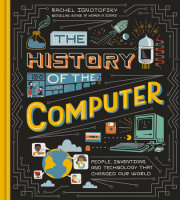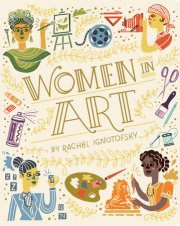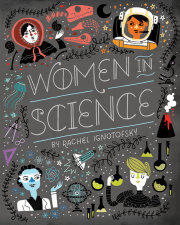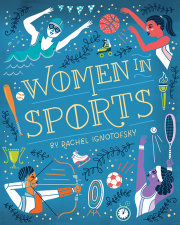INTRODUCTION “The weaker sex!” It wasn’t the first times those untrue words were said, and it wouldn’t be the last. It’s what Bobby Riggs, a former tennis champ, said about women in 1973. But tennis player Billie Jean King stood up to this bully. With masterful skill, physical strength, and a sense of self-worth, Billie Jean would change the world with her tennis racket.
Throughout history, women have been stereotyped as weak and routinely excluded from competitions, gyms, teams, and sports clubs. With no arena in which to prove themselves fit and strong, it was hard for women to fight this sexism. Of course, this stereotype has pervaded other segments of society throughout history. Women have been denied educational, civic, business, and leadership opportunities and have had to prove they are just as smart and hardworking as men. Female athletes like Billie Jean have had to fight the most basic stereotype of all: that women’s bodies are inherently not as strong or capable as men’s. Their progress has been truly inspiring.
During the 1970s, the feminist movement was in full swing in the United States, United Kingdom, and other developed nations. Women were demanding equal pay and equal opportunities. In 1972, the United States passed Title IX as part of the Education Amendments, making it illegal for U.S. schools to discriminate in funding based on gender. For the first time, many schools began funding women’s sports programs, and colleges began giving out women’s sports scholarships. Finally, women could pursue their athletic passions and show the world their true strength.
The backlash was inevitable. Many still thought women should do only traditional “ladylike” activities. Tennis player Bobby Riggs wanted to prove that women had no place in sports by beating the best female tennis player, Billie Jean King. In 1973, he challenged her to a “battle of the sexes” tennis match. At first she declined. But when Bobby beat Grand Slam winner Margaret Court in the “Mother’s Day massacre” game, Billie Jean understood there was more at stake than just a tennis match.
The whole world was watching as Billie Jean and Bobby entered the tennis court. Winning would not be enough; she would have to wipe the floor with him. And she did: 6-4, 6-3, and 6-3 for each set. Billie threw her racket into the air in victory as the crowd went wild!
Women around the world watched Billie Jean and felt empowered to stand up for themselves. Many thanked her for inspiring them to finally ask for a pay raise or a promotion. Men wanted their daughters to grow up strong and brave like Billie Jean. She used her sports star status as a leader off the court as well, lobbying and creating initiatives for equal opportunities in the workforce for women and people of color. This is the cultural power of sports: through entertainment and competition, they inspire courage. The fight for social justice often starts in the field or on the court. Through historic victories and setting new records, female athletes like Billie Jean shared their stories, broke down stereotypes, and created change.
Sports have always been a part of human culture, and athletes become heroes, social icons, and positive role models. Although sports should be about skill and hard work, societal prejudices often prevented women from competing. It took gutsy, fearless women to break down these barriers—to defy the rules, be resourceful, and take dangerous risks—all to prove their strength, independence, and ability to lead and change the world.
When the newspapers scoffed that a “weak “woman like Gertrude Ederle couldn’t swim across the English Channel, Gertrude decided that she would either drown or triumph. She triumphed—and set a new world record in 1926. When Althea Gibson, a black woman, played tennis during the segregation era, her talent was so undeniable she was able to cross the color line and become the first African American to showcase her skills at Wimbledon. The world would judge her on her skills, not her skin color, helping the civil rights movement and paving the way for athletic greats like Serena Williams. When Sue Sally Hale was told women were not allowed to play polo, she disguised herself as a man for 20 years to play the sport she loved. Sue Sally eventually leveraged her secret to force polo to become a co-ed sport, allowing her to become a leader on the field.
These are just a few examples of female athletes who proved their worth as individuals, showing the world what women can do and creating more opportunities for future generations. There are still problems in women’s athletics, such as a lack of funding and media coverage, and unequal pay. But with each generation, women defy expectations and accomplish feats of strength that challenge the status quo. This book is filled with stories of little girls who grew up to achieve their greatest dreams—stories of women who pushed themselves to the limit, did the impossible, and became legends.
Copyright © 2017 by Rachel Ignotofsky. All rights reserved. No part of this excerpt may be reproduced or reprinted without permission in writing from the publisher.




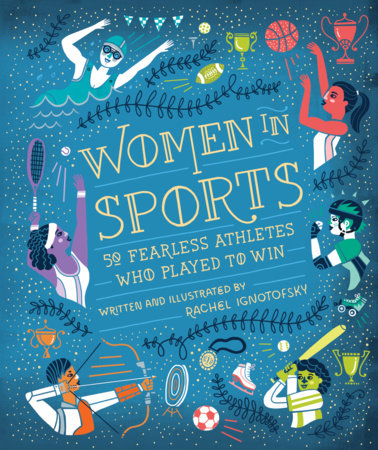



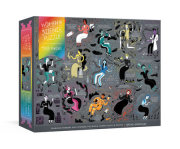


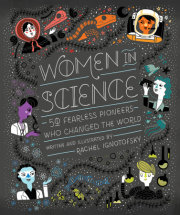




![The Women Who Make History Collection [3-Book Boxed Set]](https://images.penguinrandomhouse.com/cover/9781984861740?width=180)
